The Employee Profile in China Pharma R&D
In this analysis, distinctions between who hires who in non-Chinese and China-based companies emerges.
Pharmaceutical companies are currently targeting the emerging markets of China and Africa for their future expansion, with the highest investment - USD 5.32 billion - just in China alone. Around 29 plants with a combination of manufacturing, production units and research & development centers are scheduled to open through the 2015 to 2022 period across regions. In addition to new facilities, approximately five brownfield expansions and nine closures are also scheduled within the same period. Figure 1 shows the various expansions vs. closures regionally planned by the top 10 big pharma companies. 1
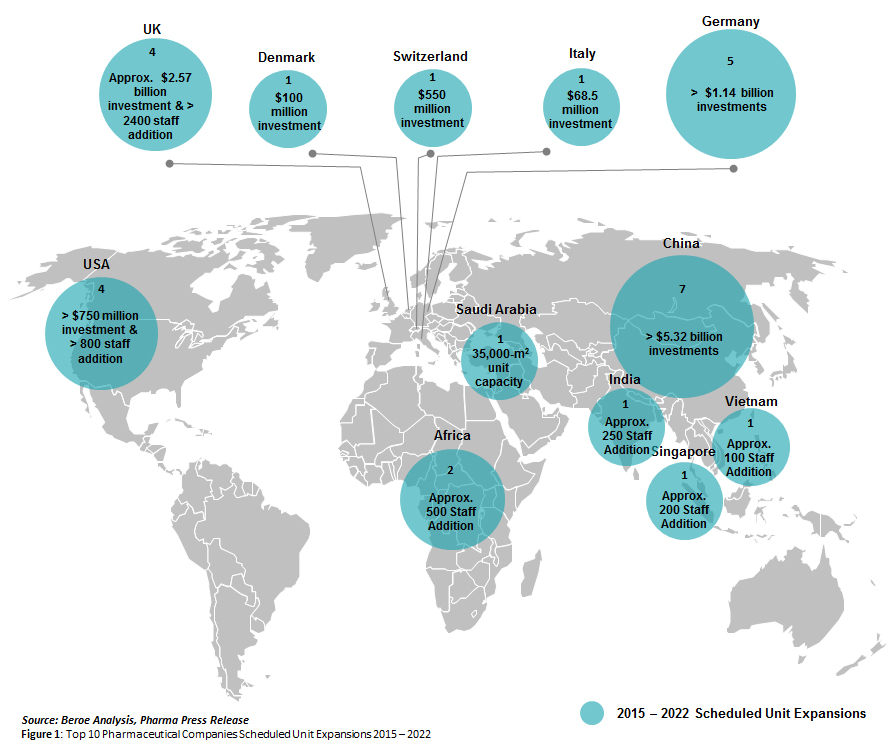
Pharma companies are expanding their manufacturing and R&D facilities at a rate of 32% in China, which is four times greater than the forecasted investment for the United States during 2015 - 2022.1 This has caused a surging demand for R&D professionals in China from both local and global CROs and pharma that are actively hiring. Table 1 shows the expansions scheduled in China.
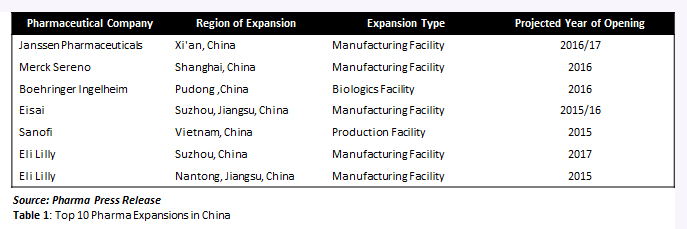
For our purposes, we focus only on professionals from the clinical-pharmaceutical field, leaving out medical devices. All in all, over 2,000 resumes of Chinese R&D professionals, 33.5% employed at global pharma players and 66.5% at local, China-based organizations were considered for this analysis. For starters, 45.9% come from WuXi Pharma, the Shanghai-based Chinese CRO market leader. Top 10 companies make for 83.5% of the 2,107 profiles analyzed. They are: WuXi Pharma, Shangpharma, Pharmaron, Novartis, GSK, Parexel, Johnson & Johnson, Pfizer, GenScript and Sanofi. Excluding WuXi Pharma doesn’t change fundamentally the patterns identified in our analysis: the few instances in which it does will be properly highlighted.
At First Glance
R&D professionals within China are on average 33 years old and predominantly male (62.8%). As level of seniority increases, this gender unbalance becomes more acute: about 70.5% of managers are men. Men are in general slightly more seasoned than women and a little older: 76.5 vs. 68.0 months of working experience; 33.2 years old vs. 32.2, respectively.
Pharma R&D talent has an average work experience of 73.8 months, which is roughly 6 years and 2 months, and an employment stability of 33.8 months or 2 years 9 months. For managerial positions, R&D professionals have on average 117.8 months of working experience and are 37.6 years old. Young professionals (those with less than four years of working experience) represent 30.8%, whereas senior professionals (8 years and above) are 22.8%.
The Yangtze River delta (Shanghai, Nanjing, Suzhou, etc) accounts for 70.3% of the professionals; the Bohai economic rim – comprising the northern cities of Beijing, Tianjin, Dalian or Qingdao – adds up to 15.8%; and the Pearl River delta in the south (Guangzhou, Shenzhen) makes for 3.3%.
Noteworthy are the cases of Beijing and Shanghai: the latter holds the lion’s share with 57.4% of professionals, Beijing follows with 14.9%. At the province level comes Jiangsu (8.5%), then Guangdong (3.5%) and Tianjin (3.1%).
Discounting WuXi dilutes the relative weight of Shanghai (57.4% to 46.9%)--where the local powerhouse has a strong foothold--and reflects in a relatively higher proportion of professionals located in Beijing (from 14.9% to 24.2%). The relative balance of forces remains almost invariably within the top 10 locations by province, except for Tianjin in the north where WuXi has one R&D facility. Tianjin ranks as the 11th most common location of R&D professionals when WuXi is excluded.
Differences
The most discerning feature that was found when dissecting data in search for talent patterns was whether the organizations were Chinese or non-Chinese based. Let us take a look into the main differences between them.
Work experience
Non-Chinese based companies rely more on experienced staff than its local peers. Overall, R&D professionals at the former have a total work experience of 86.2 months (7 years, 2 months), in stark contrast with the 5 years, 7 months at Chinese organizations.
Non-Chinese based players rely on more experienced staff than its Chinese peers, however, the latter are more successful, if only slightly, at sourcing stable personnel. Young professionals represent 23.2% of the total R&D segment in non-Chinese companies, whereas this proportion is nearly 1.5 times higher at Chinese companies: 34.5%. The opposite is true for senior professionals: 17.1% in Chinese companies and double in non-Chinese ones (34.3%).
Now, all things considered, there are no significant differences in overall employment stability between Chinese and non-Chinese based companies. If any, the former present slightly superior employment stability: 34.1 versus 33.2 months. Furthermore, for every level of seniority measured, Chinese organizations yielded slightly better employment stability figures.
At the managerial level, managers are relatively less stable in non-Chinese companies--51.8 months per employer and 71.9% of them moving before 4 years--but more seasoned: on average 130.7 months of working experience and 39.9 years old. Managers at Chinese companies are younger (36.3 years old) and less experienced (110.3 months) but relatively more stable at 52.8 months, with 58.9% remaining less than four years per employer.

Geographical location
Interesting differences can be observed between Chinese and non-Chinese organizations when looking at their respective talent distribution.
Non-Chinese pharmaceuticals have a less prominent presence in the Yangtze River - 52.1%, as compared to the 79.5% from local companies. This is due to their lower presence in Shanghai, where they concentrate only 37.6% of their R&D talent, whereas for Chinese organizations this is 67.4%.
In fact, non-Chinese pharmaceutical companies’ talent is almost as present in Beijing as in Shanghai (31.5% and 37.6%, respectively) while Chinese organizations’ talent is, in comparison, practically dismissing Beijing with only 6.6% of its R&D talent located there.
Gender balance
Non-Chinese organizations are more gender balanced than local ones: 44.3% vs. 33.7% women respectively. However, as working experience goes up in non-Chinese companies the gender gap increases as well. So, if at young professionals’ level women represent 50% of the workforce, this comes down to 47.2% for mid-level experienced professionals (between four and eight years of working experience) and settles to 36.9% for the most experienced segment of R&D professionals. The same trend is observed in local organizations, though the gender unbalance there is more pronounced.
Women are less likely to reach managerial responsibilities in the R&D functional area at non-Chinese organizations, with only 24.1% of managers there being women as opposed to 32.1% at local companies.
Talent Supply and Talent Demand
The current location of R&D professionals has been compared with the distribution of job ads published by the same set of employers in 2014 in Chinese online job boards such as 51jobs or Zhaopin.com. Overall, 307 job ads were gathered. Most of the openings referred to researchers and R&D specialists (92.6%), which are noted as the most available professionals (92.5%).
The analysis reveals that filling up positions in Shanghai and Beijing should be relatively easier, since proportionally the distribution of supply is greater than demand. However, the job-ads analysis doesn’t include specific job requirements or compensation details. These two factors may shrink the actual size of relevant supply, for not all professionals meet job requirements and compensation expectations in tier-1 cities such as Shanghai or Beijing. Shanghai, which accounts for 57.4% of the professionals, accumulated 38.8% of the job ads in 2014; Beijing concentrates 10.4% of the opening opportunities while the pool of professionals there amounts for 14.9% of the total.
On the other hand, distribution of the demand is higher than supply at Jiangsu and Zhejiang provinces. That’s especially true in Jiangsu, where demand is almost 11 percentage points above talent availability: 19.2% vs. 8.4%. At Zhejiang we observe a difference of three percentage points, with demand at 4.9% overtaking the supply (1.9%) (Figure 2).
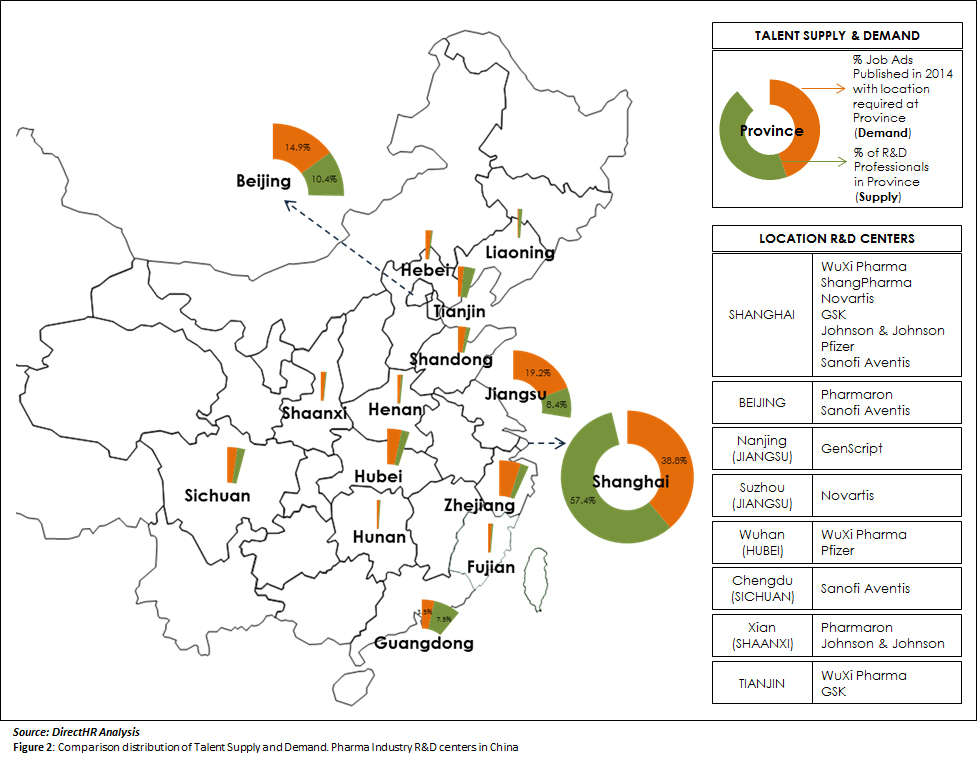
The differences in talent demand coming from Chinese and non-Chinese companies were tested separately. To compare the results the average deviation of the differences (in absolute value) between the distribution of R&D professionals and distribution of open job opportunities by province: 1.5 in the case of Chinese companies versus 2.2 for non-Chinese ones, was used. To conclude, Chinese local firms are doing a better job in reading the talent market, with a demand more in line with the distribution of the supply, at least from a geographical perspective.
The above remains true even if the supply is split by type of company: there are more divergences in the geographical distributions of the supply and job ads when looking only at non-Chinese than there are for Chinese companies.
Educational Background
The most common major R&D professionals have studied Chemical Sciences (31.7%), followed by Pharmacy (15.9%), Pharmacology (12.0%), Biology (9.7%) and Chemical Biology (8.2%) as shown in Table 3.
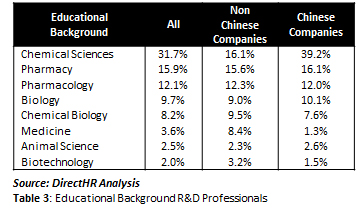
Local companies rely more intensively on professionals with a Chemical Sciences background (39.2%) than non-Chinese (16.1%). That makes top 5 majors in Chinese companies account for 85.0% of the R&D professionals, while in non-Chinese companies this is 62.5%. (Table 4)
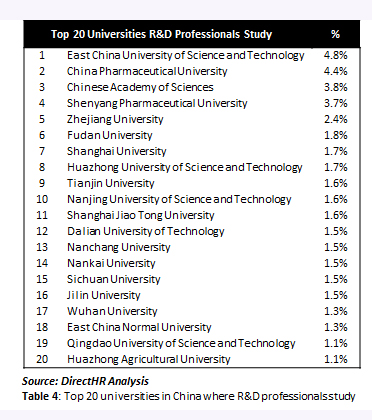
Shanghai and Jiangsu, in the Yangtze River delta, are the provinces where most of the talent in R&D has studied: 19.9% and 15.7% respectively. This is followed by Beijing (9.1%), Hubei (6.9%), Liaoning (6.5%) and 4.7% that graduated from overseas universities. Non-Chinese organizations source less professionals coming from universities in Shanghai and Jiangsu than their Chinese peers: 31.5% and 37.6% respectively, and focus more intensively in Beijing (15.5%, in contrast with the 6.0% of Chinese) and professionals with overseas studies (11.1% versus 1.6% in Chinese).
Another interesting insight comes when comparing where R&D professionals studied and their current location, with Shanghai and Beijing being net importers of university graduates. Only 28% of the professionals in Shanghai have indeed studied there: the rest come mainly from the neighboring Jiangsu (15.5%) and Zhejiang (3.3%) provinces, Hubei in Central China (5.8%), Liaoning in the north east (5%) or Beijing (3.3%).
A relatively higher proportion of professionals based in Beijing have studied there (33.2%) in comparison with Shanghai. Professionals in Beijing with overseas studies represent 9.4%, as opposed to the 3% in Shanghai – which is due to the relatively higher implementation of non-Chinese companies in Beijing than in Shanghai and their relatively higher probability of hiring someone with overseas studies. Talent in Beijing also comes from universities from Liaoning (10%), Tianjin (4.5%) and Hebei (4.2%). (Table 5)

Key Takeaways
The talent pool of R&D professionals for the pharmaceutical industry in China concentrates fundamentally along the Yangtze River delta: 70.3% of the professionals analyzed are located there. The key location is Shanghai at 57.4%.
Important differences emerge though between the location strategies of local pharmaceutical companies and foreign, non-Chinese, based organizations. Whereas the former are predominantly located in Shanghai (67.4%), the latter mostly split their R&D operations between Shanghai (37.6%) and Beijing (31.5%).
R&D talent at non-Chinese based firms holds, on average, more working experience (7 years, 2 months) than their colleagues at Chinese firms (5 years, 7 months). This is mostly due to the fact that Chinese firms are betting more intensively on young talent (less than 4 years of working experience) and only 17% of the R&D functions there are held by professionals with more than 8 years working experience.
Organizations looking for R&D professionals should bear in mind that on average they will remain about 2 years and 10 months before moving to another employer; for managers this is significantly higher (52.4 months, or about 4 years 4 months). 82.5% of the profiles analyzed stay less than 4 years per employer, (63.6% in managers).
Finally, Chinese firms seem to have a better grasp on the talent supply landscape for R&D professionals in China. The distribution of their job openings matches better the supply than openings coming from non-Chinese based firms.
Katherine Ni is Marketing Assistant, at Direct HR Ltd.; Juanjo Cardona is Marketing Manager, at Direct HR Ltd., and Mathini Ilancheran is Senior Research Analyst at Beroe Inc.
References
1. http://www.clinicalleader.com/doc/clinical-trial-staffing-exploring-demand-and-supply-patterns-0001
Improving Relationships and Diversifying the Site Selection Process
April 17th 2025In this episode of the Applied Clinical Trials Podcast, Liz Beatty, co-founder and chief strategy officer, Inato, discusses a number of topics around site engagement including community-based sites, the role of technology in improving site/sponsor relationships, how increased operational costs are impacting the industry, and more.
Behind the Buzz: Why Clinical Research Leaders Flock to SCOPE Summit
February 7th 2025In this episode, we meet with Micah Lieberman, Executive Conference Director for SCOPE Summit (Summit for Clinical Ops Executives) at Cambridge Innovation Institute. We will dive deep into the critical role of collaboration within the clinical research ecosystem. How do we bring together diverse stakeholders—sponsors, CROs, clinical trial tech innovators, suppliers, patients, sites, advocacy organizations, investors, and non-profits—to share best practices in trial design, program planning, innovation, and clinical operations? We’ll explore why it’s vital for thought leaders to step beyond their own organizations and learn from others, exchanging ideas that drive advancements in clinical research. Additionally, we’ll discuss the pivotal role of scientific conferences like SCOPE Summit in fostering these essential connections and collaborations, helping shape the future of clinical trials. Join us as we uncover how collective wisdom and cross-industry partnerships are transforming the landscape of clinical research.